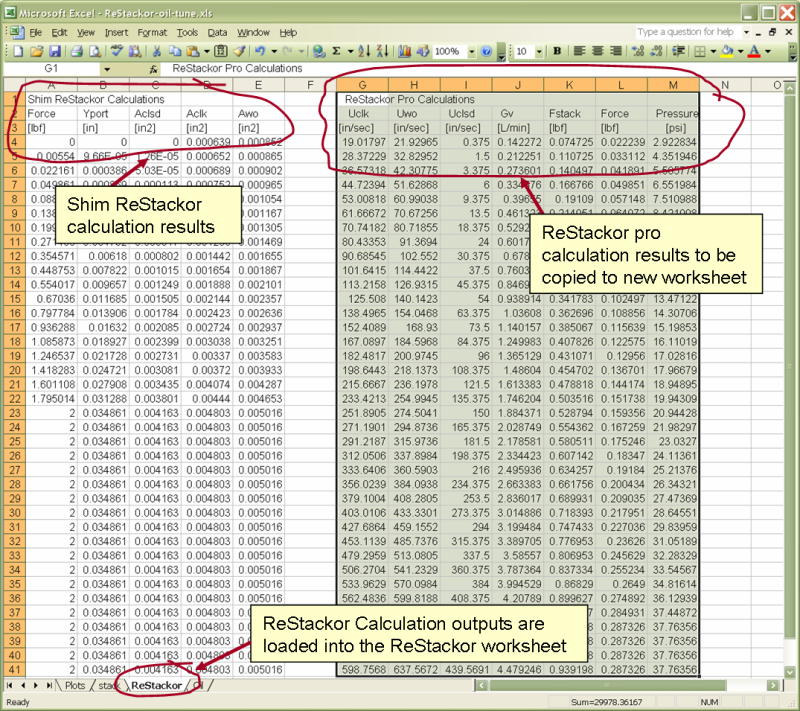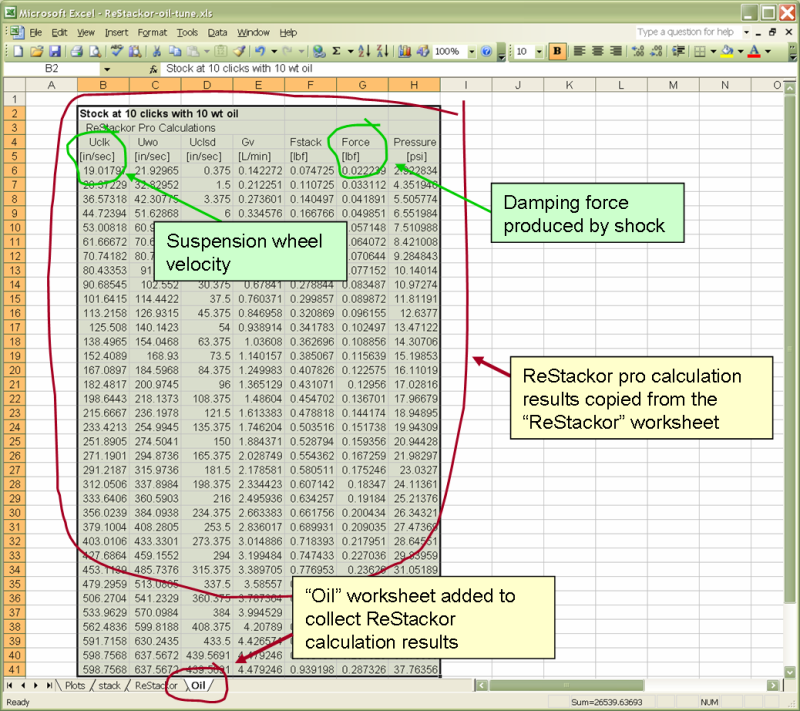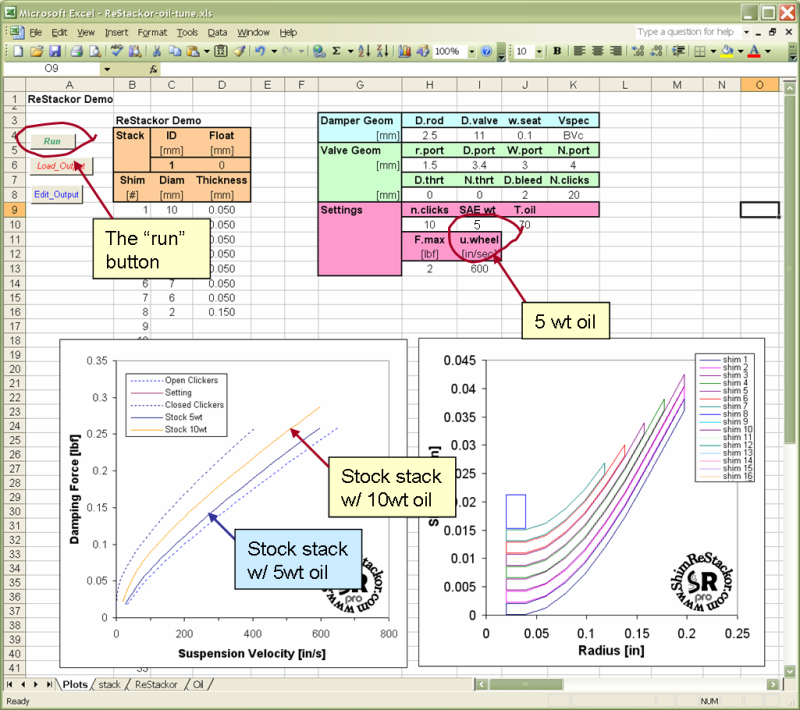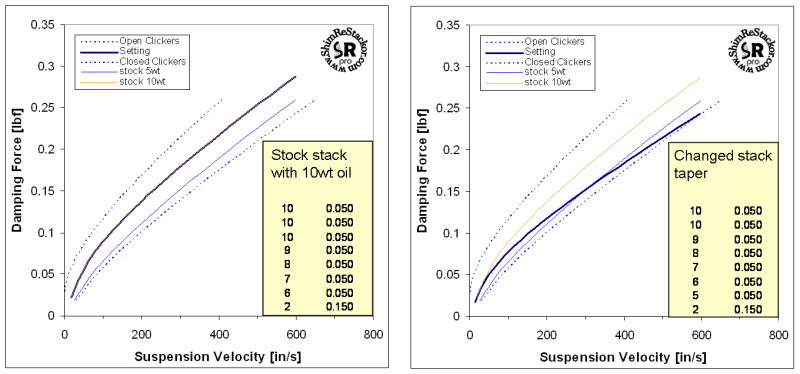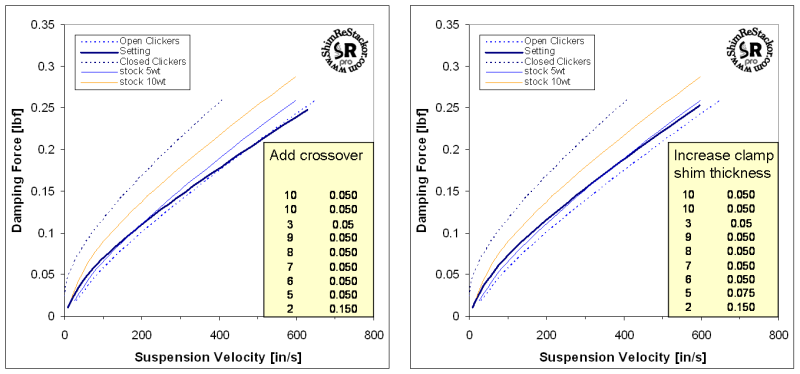

Tuning Basics
Sample Applications

ReStackor Sample Applications
Finally computer software to tune a shim stack
Oil Viscosity Tuning:
Set a shim stack to match performance of the stock stack when used with a lighter oil
One of the useful features of ReStackor pro is the capability to evaluate the effect of oil viscosity on suspension performance. This allows you to test ride your suspension with different oil weights and use that data to retune the shim stack to match specific ride characteristics. Effects of suspension fade can also be evaluated with ReStackor using the built in relationships that model oil viscosity as a function of temperature.
Lets suppose after some test rides you determine that you really like the suspension performance with 5 wt oil but you want to continue to use the stock 10wt oil for whatever reason. The example below retunes the shim stack to match 5 wt oil performance using 10 wt oil in the shock.
The example uses the demo version of ReStackor. If you have downloaded the demo you can run these calculations for yourself and develop your own stack. The ReStackor demo is limited to shim diameters of 10mm which makes the calculations very sensitive to oil viscosity due to the small scale of the valve.
The "stock" stack in this demo is a simple tapered stack with 7 shims and a 2mm clamp at the top of the stack. The valve diameter is set to 11 mm with a 2 mm bleed and a 20 click adjuster. This first calculation runs the stock stack with the clickers "centered" in the 10 click position using SAE 10wt oil. To run the case all you have to do is click the "Run" button and the embedded excel macros will write the inputs to a file and kick off a pop-up execution window to run the 11,000 lines of ReStackor code. With current computer speeds the execution of ReStackor only takes a couple of seconds.
After the run completes the ReStackor outputs are loaded into the spreadsheet by clicking on the "Load_Output" button. This loads the calculation output data into the "stack" and "ReStackor" tabs of the spreadsheet. Whenever new data is loaded all of the plots in the ReStackor spreadsheet are automatically updated.
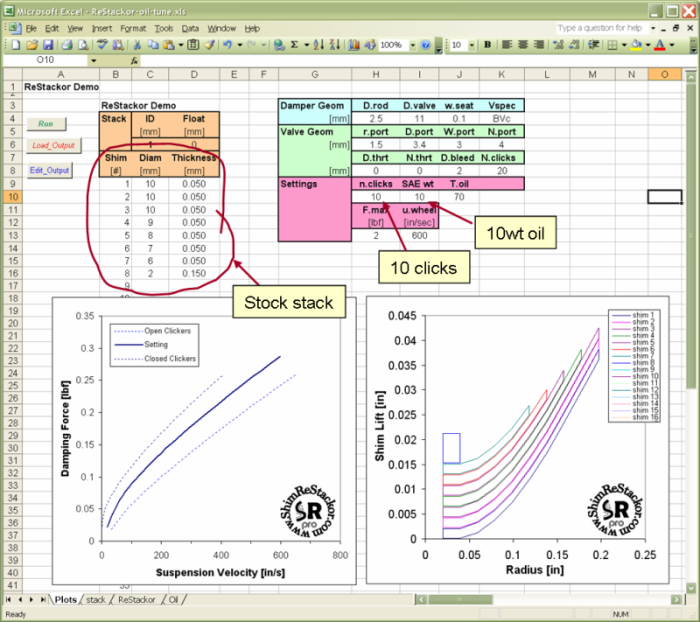
![]()
Saving calculation outputs to generate a performance map
For this example we want to compare the suspension performance with 10wt and 5wt oil so we need to save the data from the 10wt oil calculation so that the next calculation wont overwrite the outputs. A new worksheet labeled as "Oil" was added to the spreadsheet and the calculation outputs from the "ReStackor" worksheet were copied to the "Oil" worksheet.
The first step is to copy the ReStackor pro outputs in the ReStackor tab of the worksheet.
![]()
And past the table into the "Oil" worksheet. For this example we are going to the plotting the damping force produced by the suspension (column G) against the suspension velocity (column B). Definition of the parameters in the ReStackor output are given in the users manual . Here is a quick summary:
-
Uclk [=] The suspension damper rod velocity in [inches/ second]. This is the wheel velocity for a fork.
-
Uwo [=] The suspension damper rod velocity with the clickers wide open, [inches/second].
-
Uclsd [=] The suspension damper rod velocity with the clickers closed, [inches/second].
-
Gv [=] The fluid flow rate through the suspension in [liters/ minute].
-
Fstack [=] The force applied to the shim stack face, [pounds force].
-
Force [=] The damping force produced by the shock absorber, [pounds force].
-
Pressure [=] The pressure drop across the suspension valve, [psi].
![]()
Suspension performance using 5wt oil
To run the suspension performance with 5wt oil all you have to do is change the oil weight in cell I10 from 10 to 5 and click the Run and Load_Output button.
We need to save the results for the 5 wt oil calculation as well so the outputs on the ReStackor tab were copied to the "Oil" worksheet tab as well. With the 5wt and 10wt performance data collected the plot above was updated to add these two curves.
The ReStackor example here assumes you have some familiarity with the operation of excel. If you need some help with how to cut and paste data in a spreadsheet or how to added new curves to a plot check out the Microsoft web site.
With the addition of these curves for 5wt and 10wt oil we now have a performance map for the suspension. For this example we want to try and retune the stack to match the 5wt oil damping curve using 10 wt oil in the fork. This is obviously going to require a softer stack. The progression of stack modifications is shown in the frames below.
![]()
Stack modifications to match the 5wt damping curve.
The first step is to remove one of the 10mm face shims and taper the stack down to a 5mm clamp shim instead of a 6mm shim. With this modified taper the stack is closer to the 5wt curve but still to stiff at low speed and a little too soft at high speed.
To try and fix the low speed a 3mm crossover was added behind the face shims. This softens the low speed damping and moves the modified stack closer to the 5wt curve. If you really wanted to nail the 5wt curve at low speed you would need to open the clickers slightly or add some stack float.
With the low speed matched fairly well the next step is resetting the high speed stiffness. The thickness of the 5mm clamp shim was increased from 0.05mm to 0.075mm.
![]()
Retuned Stack Configuration
This example started with a simple tapered stack operating with 10wt oil and retuned the stack to match the damping rates produced with 5wt oil. The capability of ReStackor pro to model oil viscosity effects gives you the capabiltiy to test ride your suspension with different oil weights and use that data to retune the stack to match high speed, low speed or the overall performance of the suspension system.
With ReStackor it is very easy to generate a performance map for your suspension and show the effect of oil viscosity, oil temperature or clicker settings on damping rates. Plotting potential stack modifications against that performance map allows you to instantly recognize the effect of stack modifications and use your real world riding experience to retune the stack. The capability of ReStackor to do that in software allows you to tune your suspension far beyond the levels those previously possible.
![]()
ReStackor Suspension Performance Map Simplifies the Tuning Process
Tuning a shim stack with ReStackor is a simple process. With a couple of calculations you can produce a performance map for the stock suspension and plot potential stack modifications relative to that map. This allows you to instantly evaluate stack modifications in terms of clicker settings or oil viscosity effects. If you are looking for a three click softer setting you can immediately dismiss stack configurations that produce stiffer stacks. This simple reference to clicker settings will save you a huge amount of time in suspension tuning by preventing you from wasting your time installing and testing stacks that are outside the range of interest.
Stack Parameters can be Designed to Produce Specific Effects
For the example above matching the desired damping rates required the addition of a crossover shim, changes to the stack taper and the stack clamp diameter. You would never arrive at that stack tuning by the seat-of-the-pants. With ReStackor the evaluation of the effects of crossover shim placement and diameter are simple to interpret. Stack taper effects are easily adjusted and the clamp shim diameter can be easily tuned to produce the desired effect. The capability to confidently implement multiple stack changes allows you to tune the shim stack far beyond levels previously possible. ReStackor introduces an entirely new era to suspension tuning.
ReStackor allows you to fine tune your suspension far beyond levels previously possible
After installing and testing riding your suspension you may find the modifications you thought you wanted were not what you needed. Here, ReStackor can help you retune the stack to something midway between the stock stack and the new stack or further modify the stack to something even stiffer or softer. The capability of ReStackor to interpret clicker settings and the effect of oil viscosity allows you to use your real world riding experience to tune the shim stack and set the stack stiffness to produce specific effects at specific wheel velocities. This is a huge improvement in your capability to tune a stack.

